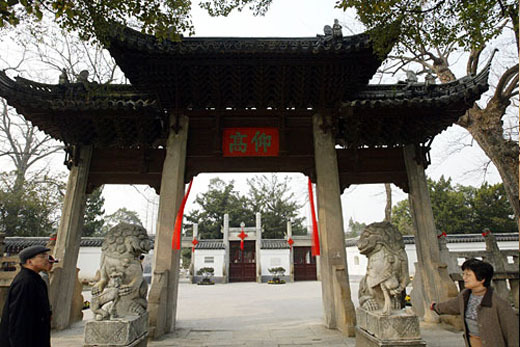
Shanghai Confucius Temple is an ancient architectural complex in downtown Shanghai. Since its establishment in 1294, the temple has been moved several times – but has always maintained its status as the highest learning institution in Shanghai in ancient times. The temple's current site was chosen in 1855 and covers an area of 1.13 hectares. Most of the present day buildings were reconstructed or restored in 1999 to celebrate the 2550th anniversary of the birth of Confucius (551BC-479BC), whose theories have had great influences on traditional Chinese politics, economics, philosophy, ethics, education and art.
The main entrance gate is called Ling Xing Gate, which is the traditional entrance to Confucian temples, and protected by two stone lions. Go through a courtyard and Da Cheng Gate, and you will see a larger rectangular courtyard. If you visit the temple on Sundays, you are very likely to catch a glimpse of a second-hand book market in this yard. Old Chinese comic booklets and calligraphy works for collection are sold at various stalls from 7:30am to 4:30pm every Sunday. At the end of the yard lies Da Cheng Hall, one of the main buildings of the temple complex. It contains a statue of a seated Confucius in the center and his favorite musical instrument, drums with bells, on both sides. On the walls are stone tablets carved with the entire text of "Analects," the collection of Confucius' teachings compiled by his students.
The small path on the right side of Da Cheng Hall will lead you to a gate that opens on to Zun Jing Pavilion, another main building of the complex. To go through the gate, you need to show a ticket bought at the office on the right side of the entry of Ling Xing Gate. This pavilion was originally used as a library containing volumes of the Confucian Classics and now houses a museum of calligraphy works. Walk down from the hall, and you will reach Ming Lun Hall, used as a lecture hall in ancient times. Here you can still see low wooden desks and chairs resembling those used by students hundreds of years ago. Walk further down and you will see a courtyard flanked by a corridor and a little pavilion. The corridor provides an exhibition of ancient tablets and the pavilion has seats for you to enjoy a beautiful view of a little pool flanked by the Confucian Study Hall and Kui Xing Pagoda. Go through the yard and you will find the Etiquette Gate before reaching Study Gate at the end.
Standing in front of Study Gate, you can turn left and stroll around the pool. First you will come to Kui Xing Pagoda (1730; restored 1855), the oldest structure at Wen Miao Temple. This three-storey pagoda is an attractive hexagonal structure towering 20 meters high. Opposite the pagoda and by the pool is Ruxue Shu, a former classroom for Confucian studies now used to display traditional Chinese ceramics and porcelain teapots. The pool and the buildings around it as well as weeping willows and other lush greenery make for a small but lovely garden.

Copyright ©1999-2011 Chinanews.com. All rights reserved.
Reproduction in whole or in part without permission is prohibited.